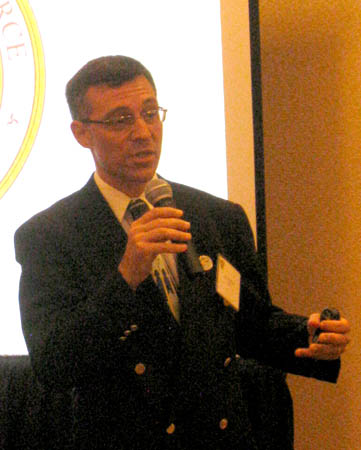The  Air Force chief scientist’s office will release “Cyber Vision 2025” later this month, said Mark Maybury, chief scientist, on July 17. The roughly 80-page document—a follow-on to the recently released Energy Horizons vision paper—details the way ahead for cyberspace science and technology, acquisitions, and accessions, stated Maybury during an AFA-sponsored Air Force breakfast program address in Arlington, Va. Cyber Vision 2025 draws heavily on input from combatant commanders and major commands as well as industry and academia, said Maybury. In the document, the Air Force breaks down cyber-related goals in the near term (Fiscal 2012 to Fiscal 2015), mid term (2016-2020), and far term (2021-2025) and identifies whether the service will become a technology leader, follower, or watcher, he said. For example, finding a common operating platform across Air Force and joint systems, or measuring cyber operator stress levels are areas where the Air Force will lead and likely invest in, said Maybury. There is no reason for the Air Force to reinvent programs already in the works in national labs or industry. Those would more likely be areas where the service will follow or watch, he said.
Air Force chief scientist’s office will release “Cyber Vision 2025” later this month, said Mark Maybury, chief scientist, on July 17. The roughly 80-page document—a follow-on to the recently released Energy Horizons vision paper—details the way ahead for cyberspace science and technology, acquisitions, and accessions, stated Maybury during an AFA-sponsored Air Force breakfast program address in Arlington, Va. Cyber Vision 2025 draws heavily on input from combatant commanders and major commands as well as industry and academia, said Maybury. In the document, the Air Force breaks down cyber-related goals in the near term (Fiscal 2012 to Fiscal 2015), mid term (2016-2020), and far term (2021-2025) and identifies whether the service will become a technology leader, follower, or watcher, he said. For example, finding a common operating platform across Air Force and joint systems, or measuring cyber operator stress levels are areas where the Air Force will lead and likely invest in, said Maybury. There is no reason for the Air Force to reinvent programs already in the works in national labs or industry. Those would more likely be areas where the service will follow or watch, he said.
Airmen basic rarely go on to become four-star generals, but one who did retired last week after a 42 year career that saw him rise from a lowly slick-sleeve to the head of one of the Air Force’s most important major commands.